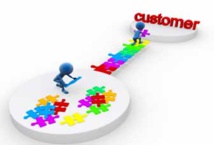Thestrategist.media – 27 April 2015 – According to Catherine Palmieri, the ability to predict the “next big thing” is “incredibly poor” among the consumers. In fact, their “reaction to new technology” mostly shows resistance. Consequently, many company executives are facing a challenge of synthesising between the driving-change as a competitive survival tactics and choosing the right move so as to be accepted by the consumers.
In order to hit the right balance, various companies assign experts to conduct a “market research” until they explore and exhaust all the possibilities and analyze strategic plans. In spite of all these ado, mostly the companies remain somewhat uncertain as to “which direction to pursue”.
Nevertheless, as per Palmieri, “The answer is often hiding in plain sight” as in most cases the company executives “know their customers better than” the latter realize. In fact, in some instances, the executives know their customers even better than the “customers know themselves”. Consequently, records show that many “unnerving” products like ATM booth, Walkman, Amazon, and CitiMobile apps were launched in the market when people thought that they didn’t any need of all these things. Yet, these, very novel step, taking then, caused a fundamental impact in our lifestyle.
According to Palmieri, when Citibank installed ATM booths in 1977, “all over” the city of New York, “people were still wary of ATMs”, as the notion of “entering a code into a machine” to withdraw money was frightening to them. Moreover, when Walkman came out in 1979, retailers showed concerned as to sell “a portable music playback device that didn’t also record”; while Jeff Bezos’s launch of Amazon in 1995 came during a time when 97% Americans “had no online access” wherein the 42% “never heard of” the platform called “Infobahn”.
In fact, a research conducted by “Forrester and Ofcom” states that in 2007, during Citibank’s launch of “CitiMobile” 87% of mobile users were not accessing the net from their “mobile device” wherein almost 72% of them expressed their disinterest towards mobile net banking. Therefore Palmieri says that the key to know the reason behind these successful market launches among others, is:
In order to hit the right balance, various companies assign experts to conduct a “market research” until they explore and exhaust all the possibilities and analyze strategic plans. In spite of all these ado, mostly the companies remain somewhat uncertain as to “which direction to pursue”.
Nevertheless, as per Palmieri, “The answer is often hiding in plain sight” as in most cases the company executives “know their customers better than” the latter realize. In fact, in some instances, the executives know their customers even better than the “customers know themselves”. Consequently, records show that many “unnerving” products like ATM booth, Walkman, Amazon, and CitiMobile apps were launched in the market when people thought that they didn’t any need of all these things. Yet, these, very novel step, taking then, caused a fundamental impact in our lifestyle.
According to Palmieri, when Citibank installed ATM booths in 1977, “all over” the city of New York, “people were still wary of ATMs”, as the notion of “entering a code into a machine” to withdraw money was frightening to them. Moreover, when Walkman came out in 1979, retailers showed concerned as to sell “a portable music playback device that didn’t also record”; while Jeff Bezos’s launch of Amazon in 1995 came during a time when 97% Americans “had no online access” wherein the 42% “never heard of” the platform called “Infobahn”.
In fact, a research conducted by “Forrester and Ofcom” states that in 2007, during Citibank’s launch of “CitiMobile” 87% of mobile users were not accessing the net from their “mobile device” wherein almost 72% of them expressed their disinterest towards mobile net banking. Therefore Palmieri says that the key to know the reason behind these successful market launches among others, is:
“Knowing that technology that can deliver against core consumer needs will trump consumers’ anxiety or hesitation.”
Hence, Palmieri advices that “Instead of looking outside for guidance”, one needs to trust one’s insights about the customers which should go hand in hand “with a deep understanding” of the technology that can “deliver” the service intended. Moreover, executive figures should “foster an internal culture of experimentation”, whereby internal people should be given “the freedom” to experiment even though they might fail apparently.
At times, some individual trials may lead to error but when the individual imperatives are put together, “they provide a powerful approach to innovation”. It is the power of innovation that enables a company to improve on their “customer experience”. Furthermore, differentiating oneself from market competition can even lead to redefining the industry. Every innovative product that has “transformed human lives”, has ultimately “reduced the time needed to complete a task or the complexity of that task”. In fact, Palmieri says:
“Technology that can deliver against core consumer needs will trump consumers’ anxiety or hesitation.”



















